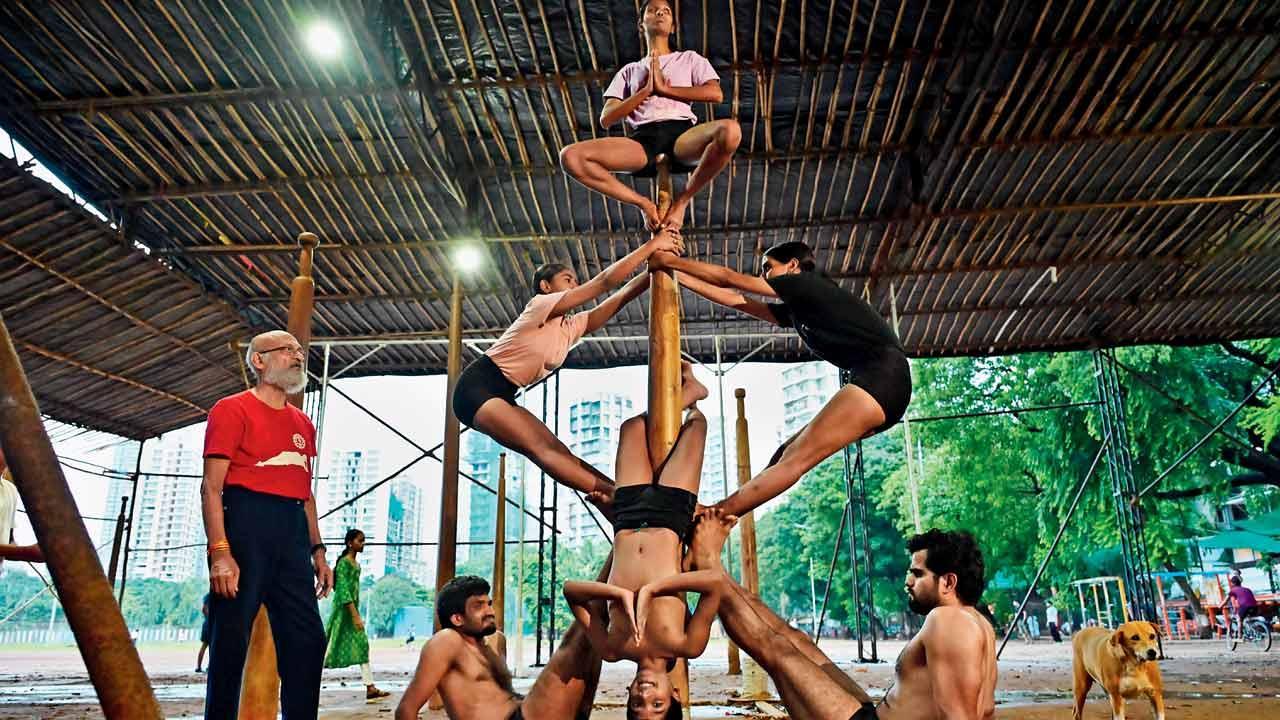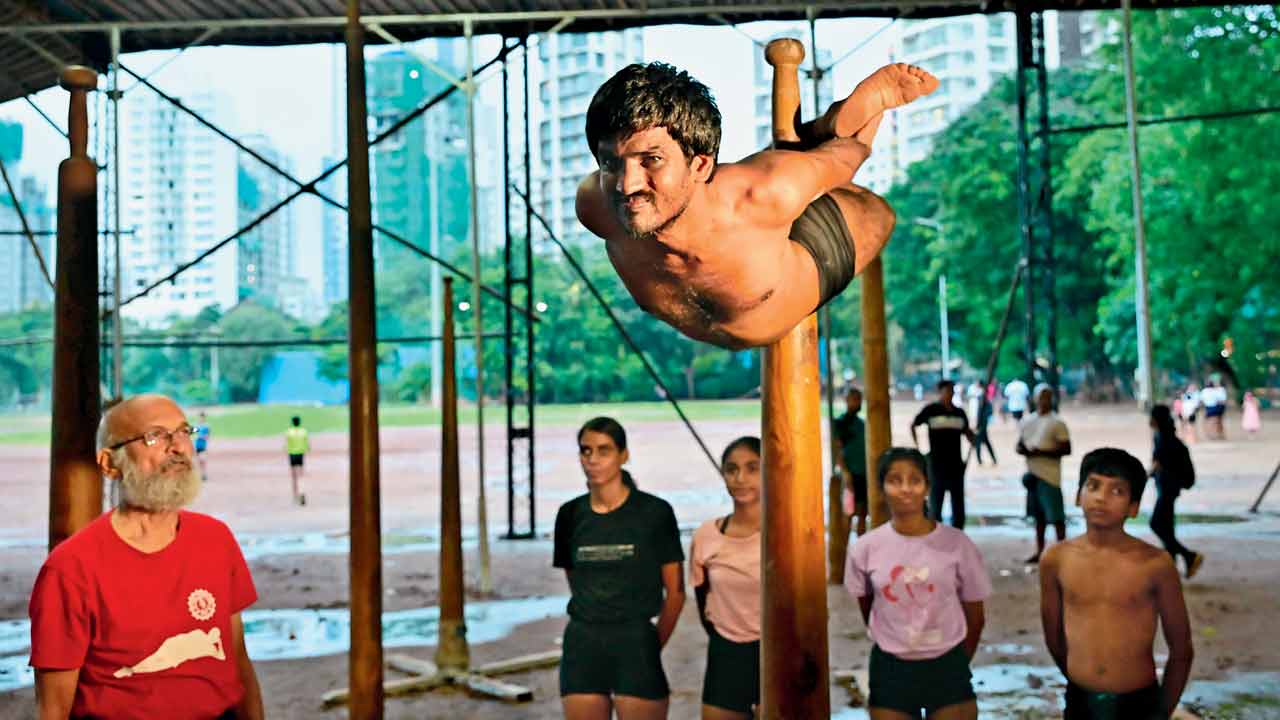A mallakhamb group, with four sight impaired players, set to perform at Olympics

A pyramid on a pole mallakhamb by the Samartha team. Pics/Shadab Khan
In October 2023, International Olympic Committee (IOC) President Thomas Bach visited India, where the IOC, in collaboration with the Olympic Museum and Reliance Foundation, signed a new agreement to expand the Olympic Values Education Programme. During Bach’s visit, a bunch of sports groups from Mumbai’s schools gathered at Reliance Corporate Park in Ghansoli to demonstrate their skills in both modern and traditional Indian sports such as kho-kho and gully cricket.
ADVERTISEMENT
One group stood out: Padma Shri Dr Uday Deshpande’s mallakhamb group of six that included four visually challenged performers. The group trains at the Shree Samarth Vyayam Mandir at Shivaji Park, and their exceptional performance is now a highlight of the Paris Olympics’ India House. It includes students aged 12 to 27, and assistant coach Dr Neeta Tatke. Among the performers, Komal Patil and Venkatesh Mandadi are 75 per cent visually impaired, while Anjali Tapal and Ajay Lalwani are 100 per cent visually impaired.
It will be the first trip abroad for every member of the squad, and emotions are running high. As the team prepares to leave for Paris on July 22, the youngest member of the squad, 12-year-old Samath Patil, expresses its excitement, “We are thrilled! We will showcase our best and spread the word about India’s sporting heritage.” He has been pursuing the sport for three years; the rest have been at it, relentlessly for three to four hours every day, for about a decade, regardless of demos and performances.

Venkatesh Mandadi performs Matsyasan on a pole mallakhamb
Pure courage and ability recommended the athletes to the task, and not special allowances. The candidates were chosen for the demo based on merit, and history of outstation representation. “There was no criteria for choosing visually impaired students,” assistant coach Dr Neeta Tatke. “Everyone is welcome to learn mallakhamb, regardless of their participation in sports in general. Whoever shows interest, and eventually picks up, is given a chance to perform. A lot also depends on their dare-devilry. They have to perform the moves at a height, say a split 8.5 feet off the ground.”
And it takes extra dedication to even get to class. “I leave Boisar at 5 am,” says Komal Patil, who can barely see the outline of figures, “and reach Shivaji Park by 7 am, and practise for at least three to four hours.” Ajay Lalwani, the oldest in the group, started learning mallakhamb at 18 years of age. The 27-year-old also cycled 7,500 km across the country in 45 days in 2021, with just verbal instructions from a guide. “I chose mallakhamb because it builds core strength,” says Lalwani, who works with the BMC’s Water Distribution department. “I didn’t want visual impairment to hold me back; I want to achieve everything a sighted person can.” His calm and confident demeanour convinces us he will.
Deshpande, the first Arjuna Awardee in mallakhamb, has been associated with the 73-year-old institution for over 68 years. “I joined when I was 2.5 years old; today, I am 71,” says Deshpande. Tatke is from the first batch of students that Deshpande trained in 1975. She has assisted him for decades. “Mallakhamb builds strong willpower and composes the mind. It is a competitive sport, a performing art, a martial art, and a fitness activity,” Deshpande says. “I visit all three blind schools in Mumbai, and observe how the sport changes their overall confidence. Mallakhamb has improved their academic performance too—from scoring 35 to 40 per cent in exams to 80 to 90 per cent after they started performing.”
This is India’s debut at the Olympics with a dedicated Country House—the India House—conceptualised by Reliance Foundation and the Indian Olympic Association. The House will commemorate 100 years since India first participated in the Olympics. It will be a “home away from home” for the athletes where they can interact with fans, apart from celebrating medal wins. The House will also showcase the nation’s sports, music, culinary specialities, and experiences such as yoga, music, and dance forms.
Coming back to the sport he has dedicated his life to, coach Deshpande explains, “Mallakhamb has made significant strides in India’s sporting scene, gaining recognition and participation worldwide. Countries such as Germany, South Korea, and China have integrated mallakhamb into their school curriculum and even participate in international tournaments. Some of the international players are even better than our players.”
Does instruction have to take another form for the students? Tatke answers, “Over decades of training visually impaired children, [we’ve found] the most effective method to be concise, clear verbal instructions as such students can understand things by hearing much better.” And it works. “I can’t see anything, but I can work with instructions,” says Anjali Tapal, who is 100 per cent visually impaired. “With this opportunity to visit Paris, I made the right choice. My hard work is paying off.”
 Subscribe today by clicking the link and stay updated with the latest news!" Click here!
Subscribe today by clicking the link and stay updated with the latest news!" Click here!







